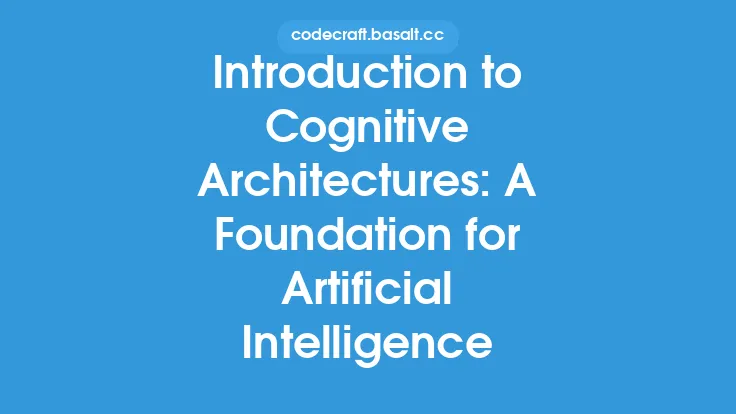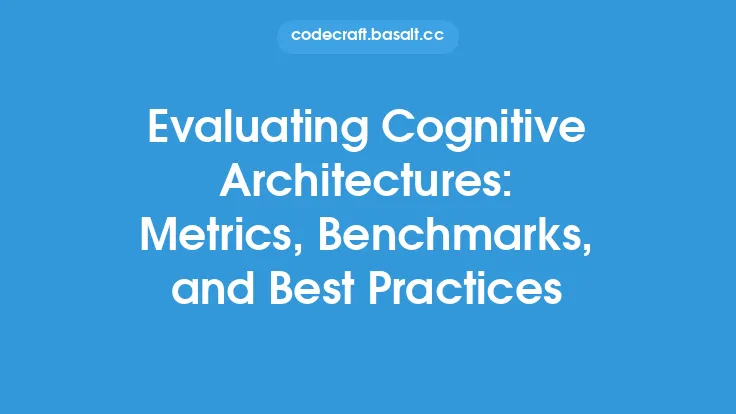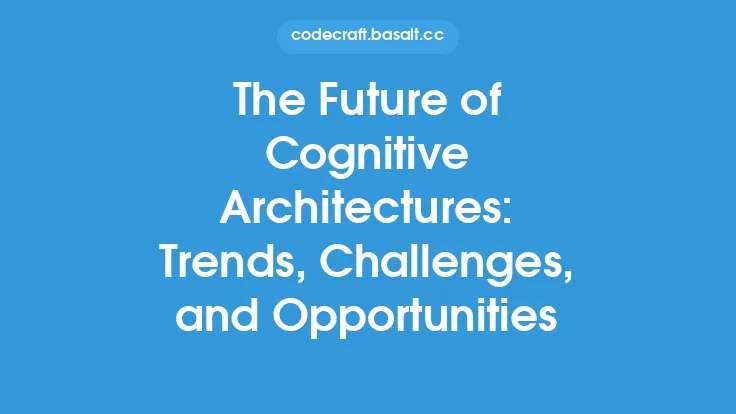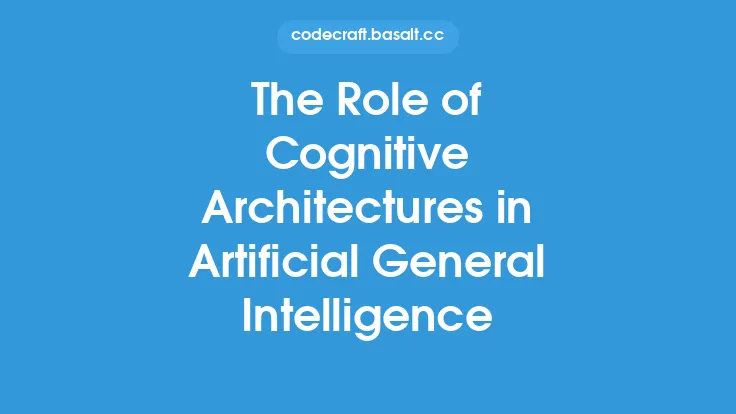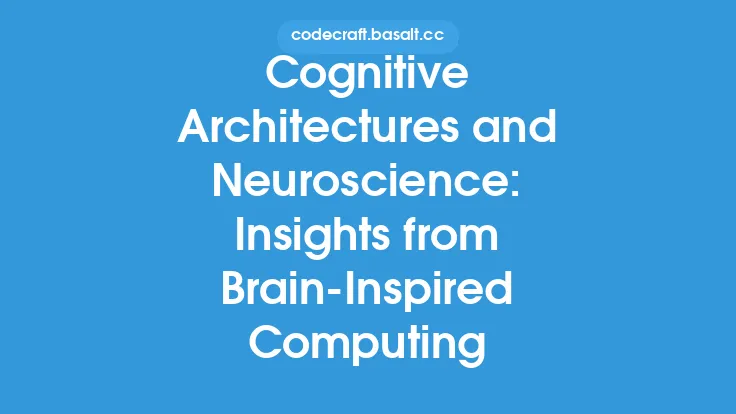Cognitive architectures are computational frameworks that simulate human cognition and provide a structured approach to integrating multiple knowledge sources for decision making. These architectures are designed to mimic the human brain's ability to process information, reason, and make decisions, and have been widely used in artificial intelligence (AI) research and applications. In this article, we will delve into the concept of cognitive architectures for decision making, exploring their components, functionality, and benefits, as well as the challenges and opportunities associated with integrating multiple knowledge sources.
Introduction to Cognitive Architectures
Cognitive architectures are software frameworks that provide a structured approach to modeling human cognition and decision making. They are designed to simulate the human brain's ability to process information, reason, and make decisions, and are typically composed of multiple components, including perception, attention, memory, reasoning, and action. These components work together to enable the cognitive architecture to perceive its environment, process information, and make decisions based on that information. Cognitive architectures have been widely used in AI research and applications, including robotics, natural language processing, and expert systems.
Components of Cognitive Architectures
Cognitive architectures typically consist of several key components, including:
- Perception: This component is responsible for processing sensory information from the environment, such as visual, auditory, or tactile data.
- Attention: This component is responsible for focusing the cognitive architecture's processing resources on the most relevant information.
- Memory: This component is responsible for storing and retrieving information, including both short-term and long-term memory.
- Reasoning: This component is responsible for drawing inferences and making decisions based on the information stored in memory.
- Action: This component is responsible for executing the decisions made by the reasoning component.
These components work together to enable the cognitive architecture to perceive its environment, process information, and make decisions based on that information.
Integrating Multiple Knowledge Sources
One of the key benefits of cognitive architectures is their ability to integrate multiple knowledge sources for decision making. This can include:
- Symbolic knowledge: This type of knowledge is represented using symbols, such as words or rules, and is often used in expert systems and other knowledge-based applications.
- Subsymbolic knowledge: This type of knowledge is represented using numerical or probabilistic models, such as neural networks or Bayesian networks, and is often used in machine learning and other applications.
- Sensorimotor knowledge: This type of knowledge is represented using sensory and motor data, such as images or speech, and is often used in robotics and other applications that require interaction with the physical environment.
By integrating these different types of knowledge, cognitive architectures can provide a more comprehensive and accurate understanding of the environment, and make more informed decisions.
Functionality of Cognitive Architectures
Cognitive architectures provide a range of functionality for decision making, including:
- Reasoning and inference: Cognitive architectures can use reasoning and inference algorithms to draw conclusions based on the information stored in memory.
- Decision making: Cognitive architectures can use decision-making algorithms to select the best course of action based on the information stored in memory.
- Planning: Cognitive architectures can use planning algorithms to generate a sequence of actions to achieve a goal.
- Learning: Cognitive architectures can use learning algorithms to update their knowledge and improve their performance over time.
By providing this range of functionality, cognitive architectures can support a wide range of applications, from simple decision-making tasks to complex planning and problem-solving tasks.
Benefits of Cognitive Architectures
Cognitive architectures offer a range of benefits for decision making, including:
- Improved accuracy: By integrating multiple knowledge sources, cognitive architectures can provide a more comprehensive and accurate understanding of the environment.
- Increased flexibility: Cognitive architectures can be used in a wide range of applications, from simple decision-making tasks to complex planning and problem-solving tasks.
- Enhanced scalability: Cognitive architectures can be designed to scale up or down depending on the requirements of the application.
- Better explainability: Cognitive architectures can provide explanations for their decisions, which can be useful in applications where transparency and accountability are important.
By providing these benefits, cognitive architectures can support more effective and efficient decision making in a wide range of applications.
Challenges and Opportunities
While cognitive architectures offer a range of benefits for decision making, there are also several challenges and opportunities associated with integrating multiple knowledge sources. Some of the key challenges include:
- Integrating different types of knowledge: Cognitive architectures must be able to integrate different types of knowledge, including symbolic, subsymbolic, and sensorimotor knowledge.
- Managing uncertainty: Cognitive architectures must be able to manage uncertainty and ambiguity in the information they process.
- Scaling up: Cognitive architectures must be able to scale up to handle large amounts of data and complex decision-making tasks.
- Providing explanations: Cognitive architectures must be able to provide explanations for their decisions, which can be useful in applications where transparency and accountability are important.
Some of the key opportunities include:
- Improving decision making: Cognitive architectures can improve decision making by providing a more comprehensive and accurate understanding of the environment.
- Enhancing human-machine interaction: Cognitive architectures can enhance human-machine interaction by providing more natural and intuitive interfaces.
- Supporting complex tasks: Cognitive architectures can support complex tasks, such as planning and problem-solving, by providing a range of functionality for decision making.
- Enabling autonomous systems: Cognitive architectures can enable autonomous systems, such as robots and self-driving cars, by providing a range of functionality for decision making and control.
Technical Details
From a technical perspective, cognitive architectures can be implemented using a range of programming languages and software frameworks, including Java, Python, and C++. They can also be implemented using a range of algorithms and data structures, including neural networks, Bayesian networks, and decision trees. Some of the key technical challenges associated with implementing cognitive architectures include:
- Integrating different types of knowledge: This requires the development of algorithms and data structures that can handle different types of knowledge, including symbolic, subsymbolic, and sensorimotor knowledge.
- Managing uncertainty: This requires the development of algorithms and data structures that can handle uncertainty and ambiguity in the information they process.
- Scaling up: This requires the development of algorithms and data structures that can handle large amounts of data and complex decision-making tasks.
- Providing explanations: This requires the development of algorithms and data structures that can provide explanations for their decisions.
Real-World Applications
Cognitive architectures have a wide range of real-world applications, including:
- Robotics: Cognitive architectures can be used to control robots and enable them to interact with their environment in a more natural and intuitive way.
- Natural language processing: Cognitive architectures can be used to improve natural language processing and enable computers to understand and generate human language more effectively.
- Expert systems: Cognitive architectures can be used to improve expert systems and enable them to make more accurate and informed decisions.
- Autonomous systems: Cognitive architectures can be used to enable autonomous systems, such as self-driving cars and drones, and enable them to make decisions and interact with their environment in a more natural and intuitive way.
By providing a range of functionality for decision making, cognitive architectures can support a wide range of applications and enable computers to interact with their environment in a more natural and intuitive way.
Conclusion
Cognitive architectures are computational frameworks that simulate human cognition and provide a structured approach to integrating multiple knowledge sources for decision making. They offer a range of benefits, including improved accuracy, increased flexibility, and enhanced scalability, and have a wide range of real-world applications, including robotics, natural language processing, and expert systems. While there are several challenges and opportunities associated with integrating multiple knowledge sources, cognitive architectures have the potential to improve decision making and enable computers to interact with their environment in a more natural and intuitive way.
